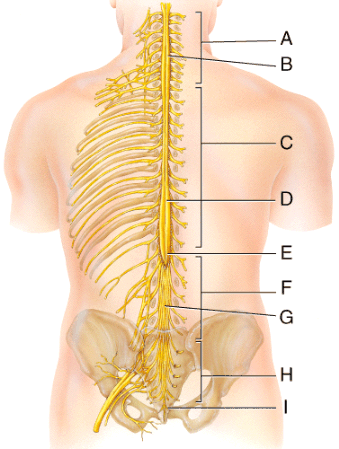Increase the surface area of the brain, making it a much more compact structure.
What is the purpose of the gyri and sulci of the cerebral cortex?
The sympathetic nervous system and parasympathetic nervous system.
What are the subdivisions of the autonomic nervous system (ANS)/visceral motor division?
Vision, audition, gustation, olfaction, and vestibular sensation.
What are the special senses?
The reflex that causes muscle relaxation.
What is the Golgi tendon reflex?
Dura mater, pia mater, and arachnoid mater.
What are the three cranial/spinal meninges?
The conscious planning and execution of movement.
What is the function of the primary motor cortex?
The longest and largest nerve in the body, belonging to the sacral plexus.
What is the sciatic nerve?
Mechanoreceptors, thermoreceptors, chemoreceptors, photoreceptors, and nociceptors.
What are the five types of sensory receptors?
Motor pathway that controls muscle below the head and neck, utilizing lower neurons of spinal nerves.
What is the corticospinal tract?
Brain waves normally seen during sleep, but only seen in awake adults with significant brain damage.
What are delta waves?
A premotor area for speech sounds in the anterolateral frontal lobe vs. the inegrative speech area located in the temporal and parietal lobe.
What is Broca's are vs. Wernicke's area?
The plexus that provides motor and sensory innervation to the upper limb.
What is the brachial plexus?
The phenomenon where visceral pain may be perceived as cutaneous pain.
What is referred pain?
The region of the brain that compares the intentions of skeletal muscle movements with the actual movement performed and then sends out corrective feedback to upper motor neurons.
What is the cerebellum?
The state of unconsciousness in which a person’s responses to stimuli are reduced or absent.
What is a coma?
Arousing the cortex from sleep and maintaining it in an "activated" (awake) state.
What is the function of the reticular activating system (RAS)?
The structure labeled "G" in the diagram below.

What is the cauda equina?
The process in which the frequency of nerve impulses in the first-order neuron decreases during prolonged stimulus.
What is adaptation?
Binds to receptors on the caudate nucleus and putamen, inhibiting the globus pallidus and, eventually resulting in the activation of the upper motor neurons.
What is the role of dopamine in motor control?
The brain's characteristic ability to change in response to intensive usage for a particular task during the process of learning (e.g. memorizing a page of physiology notes).
What is plasticity/neuroplasticity?
What is the blood brain barrier?
Stimulus --> fasciculus gracilis/fasciculus cuneatus --> medulla oblongata --> nucleus gracilis/nucleus cuneatus --> decussate --> thalamus --> primary somatosensory cortex
vs.
Stimulus --> first-order neuron --> second-order neuron in posterior horn [spinothalamic tract] --> decussate --> thalamus --> primary somatosensory cortex
What is the posterior columns/medial lemniscal system vs. anterolateral system?
The area served by a first-order sensory neuron, particularly those that serve the skin.
What is a receptive field?
1. The basal nuclei enable the thalamus to stimulate upper motor neurons of the primary cortex.
2. The basal nuclei enable the thalamus to stimulate upper motor neurons of the primary cortex.
3. Upper motor neurons stimulate lower motor neurons.
4. Lower motor neurons stimulate a skeletal muscle to contract.
5. Sensory information is relayed back to the cerebellum so movement can be modified if needed.
What are the steps/stages of motor control?
Clear, colorless liquid similar in composition to plasma that functions to protect the brain by cushioning it and maintaining a constant temperature within the cranial cavity, removing wastes, and increasing the buoyancy of the brain.
What is cerebrospinal spinal fluid (CSF) and what are its functions?